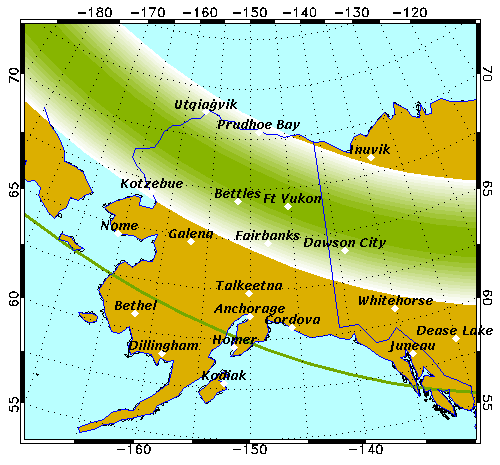
The aurora borealis, or Northern Lights, is a mesmerizing natural phenomenon that captivates observers worldwide. Tonight, February 22, 2025, Fairbanks, Alaska, is poised to offer an exceptional display, thanks to a solar storm expected to enhance auroral activity.
**Understanding the Aurora Borealis**
The aurora borealis occurs when charged particles from the sun interact with Earth’s magnetic field, causing ionization in the atmosphere and producing vibrant light displays. These displays are most commonly observed in regions near the Arctic and Antarctic Circles.
**Solar Storms and Their Impact**
Solar storms, such as coronal mass ejections (CMEs), release vast amounts of solar wind and magnetic fields into space. When these particles collide with Earth’s magnetosphere, they can intensify auroral activity, leading to more vivid and widespread displays of the Northern Lights.
**Aurora Forecast for Fairbanks, Alaska**
According to the Geophysical Institute at the University of Alaska Fairbanks, the aurora forecast for tonight indicates low auroral activity. However, if skies are clear, low-level displays may be visible overhead from Utqiaġvik to Fairbanks, and may be visible low on the horizon at lower latitudes. citeturn0search0
**Optimal Viewing Conditions**
To maximize your chances of witnessing the aurora borealis, consider the following:
– **Clear, Dark Skies:** Seek locations away from city lights with unobstructed views of the northern horizon.
– **Weather Conditions:** Check local weather forecasts to ensure minimal cloud cover.
– **Timing:** Auroral activity is often most intense during the late evening to early morning hours.
**Recommended Viewing Locations Near Fairbanks**
Here are some prime spots to observe the Northern Lights near Fairbanks:
businesses_map{“name”:”Cleary Summit”,”location”:”Fairbanks, AK”,”description”:”Located 20 miles from Fairbanks, Cleary Summit offers an elevation of 2,233 ft and is a popular viewing area with multiple pull-outs. Accessible but with sharp turns and elevation changes; all-wheel or 4-wheel drive recommended in snowy conditions.”,”cite”:”turn0search1″}{“name”:”Chena River State Recreation Area”,”location”:”Fairbanks, AK”,”description”:”Accessible via Chena Hot Springs Road, this area is generally accessible for 2-wheel drive vehicles but all-wheel or 4-wheel drive is recommended, especially in snowy conditions. Visitors should exercise caution as cell service can be spotty and moose are often in the area.”,”cite”:”turn0search1″}{“name”:”Murphy Dome”,”location”:”Fairbanks, AK”,”description”:”The highest point close to Fairbanks at 2,877 ft, located 25 miles from the city. Accessible high viewpoint but with sharp turns and elevation changes; all-wheel or 4-wheel drive recommended in snowy conditions.”,”cite”:”turn0search1″}{“name”:”Chena Lakes Recreation Area”,”location”:”North Pole, AK”,”description”:”A 2,000-acre park located 17 miles from Fairbanks, just outside of the city of North Pole. Offers lakes and trails easily accessible via well-maintained paved and gravel roads.
Safety and Preparation
Given the cold temperatures typical in February, it’s essential to dress warmly and be prepared for winter conditions. Ensure your vehicle is equipped for snowy roads, and always inform someone of your plans before heading out.
Conclusion
While the aurora forecast for tonight suggests low activity, the anticipated solar storm could enhance the Northern Lights’ visibility. By choosing optimal viewing locations, monitoring weather conditions, and preparing adequately, you can increase your chances of experiencing this breathtaking natural spectacle.

